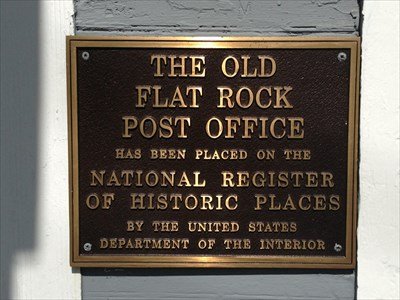The Old Post Office
/Old Flat Rock Post Office
Henderson Heritage.com
Jennie Jones Giles
In 1823, early settler John Davis bought what is today known as the Argyle property in Flat Rock. He built a home on the property.
A post office was established in the community in 1829 and John Davis was appointed the first postmaster. He also owned property near the state line in the Green River community. In 1830, Davis sold his property to Mitchell King of Charleston, S.C., and moved to his property in the Green River community.
The land deed dated Oct. 12, 1830, states that Davis sold King 1,390 acres “including the dwelling house in which I now reside, the offices, saw mills and all other dwellings and improvements.”
It was in 1830 that William Murray, who owned an inn and tavern in the Fletcher area, wrote to Mitchell King about the transfer of property from John Davis – “your property from Davis whenever it suits him to leave.” Murray moved to the King property as possibly the caretaker. By 1831 King had also purchased land from early pioneer settler John Cagle and later William Justice.
When Davis moved to the Green River community, Murray was appointed the second postmaster at Flat Rock. For more information on John Davis click here.
Peter Summey was the third postmaster. In 1836 the post office was located in the “public house or tavern.” George Summey was postmaster from 1838 to 1840 and then John Mills was the postmaster.
In 1845 the Rev. Peter Stradley was appointed postmaster. It was during his tenure that the “old post office” was built.
The Old Post Office
Historic Flat Rock, Inc
The Old Post Office was built c1845 by the Rev. Peter Stradley, who purchased the land for his home, farm and shop c1844. He was a Baptist minister, blacksmith, storekeeper and postmaster, a position he kept until after the Civil War when he was relieved of his duties because of his service as a “Civil War postmaster.” (His son was named to succeed him.)
This building was the first designated post office location. Prior to this, mail was collected at local inns or taverns. The central location of the building along the Saluda Path at the intersection of present day Little River Road made it a gathering place, not just to retrieve mail, but to hear the news. This was especially the case during the Civil War years.
Historic Flat Rock, Inc. purchased the building in 1979, and renovated it thoroughly. They use the upper floor as offices and since 2017, the first floor houses the HFR Cultural Center/Museum, fulfilling its Mission to make artifacts and collections available to the public. HFR donated a Preservation Agreement on the building to Preservation North Carolina in order to avoid the appearance of any merger of interests, ensuring the protection of the building and the agreement will survive in perpetuity.
A Short History of Flat Rock by Louise Bailey
Vital to the Flat Rock settlement was the Old Post Office, built around 1845 and served by Col. Valentine Ripley’s stagecoach plying between Greenville, South Carolina, and Greenville, Tennessee. Much excitement was created by the arrival of the mail once a week at first, then twice, and finally daily. The original building served at different times until 1965 when a new and modern facility was built.
Excerpted from …
Flat Rock
The Little Charleston of the Mountains
Sadie Smathers Patton
In 1797, a post office was established at Knoxville, with bi-monthly mail; a post route was established on a newly constructed road through Buncombe County in 1805; and in 1905, Asheville was made the Post Office and distributing office for Georgia, Tennessee and North Carolina.
The Post Office at Flat Rock, established in 1829, was for years the center of the settlement. Henderson County, at the time, had not been created, there was no thought of Hendersonville, and the postal route which ran from Asheville to Greenville, passing along the State Road, was an event of importance. As late as 1789, there were but 75 post offices in the United States, four of those being in eastern North Carolina.
Mr. C. G. Memminger’s memories of the scenes around the Post Office were many, and he dwelt at length on persons and events connected with its locale. He told his listeners:
“The Post Office was the seat of many interesting affairs. Peter Stradley, and Englishman by birth, and of fine character, was the first Post Master I can remember. The Post Office was at its present site but in a different building. Mr. Stradley was a blacksmith and had his shop beside the Post Office, in which worked his son-in-law, Jackson Barnett, a wheelwright, cabinet maker, etc, and all the Barnetts, very capable and intelligent.”
“The mail came from Greenville by four horse stage, at first bi-weekly, then daily, and great interest attended its coming. With the mailman winding his horn as he cam down Butt Mountain and the High Road, the settlement was warned of his coming. “
After the surrender at Appomattox, many of the Union troops came through (Flat Rock) …and pillaged some of the houses, and took whatever they wanted. “All the men of the community were organized and kept watch at the Post Office.








